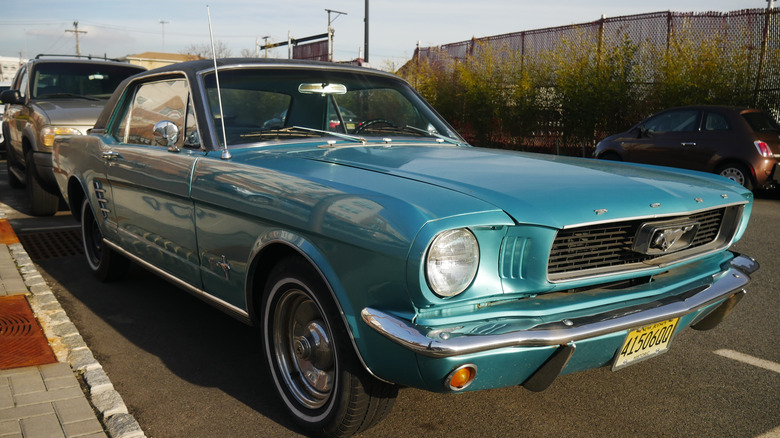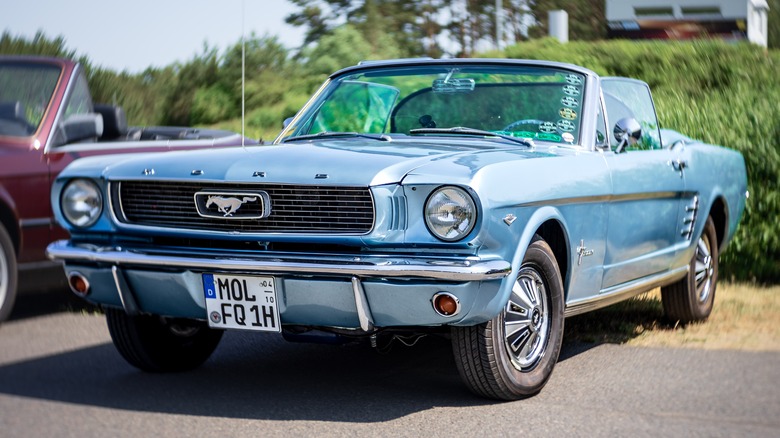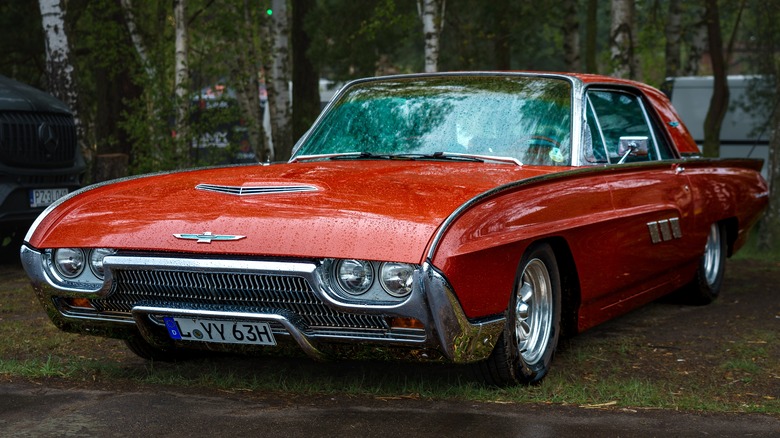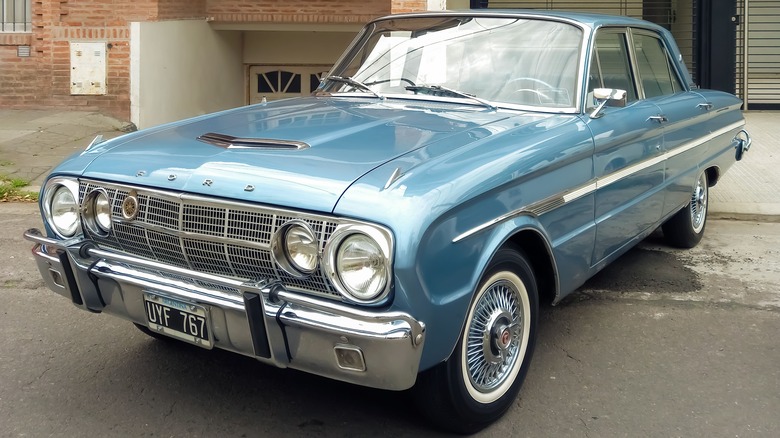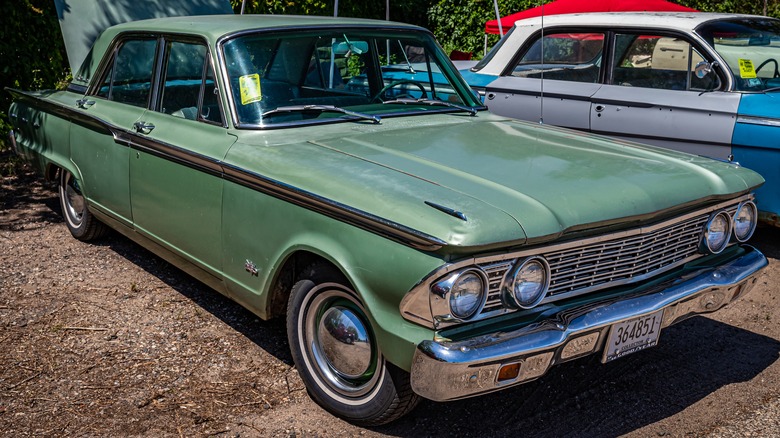The Most Iconic Ford Models From The 1960s & How Much They're Worth Today
Since its beginning, Ford has been a name associated with some of the most significant innovations within the automobile industry. As you can imagine, this reputation also extends to the cars themselves. Ford has produced countless nameplates that continue to be revered to this day, while standing as interesting snapshots of their time.
Among the most iconic time for Ford was the 1960s. Along with James Bond movies, the space race, and the revival of folk music, this era was defined by bountiful new technological and stylistic advancements for performance and passenger cars of all kinds. This was a time that would see muscle and pony cars rise in popularity, with the United States leading the run in vehicle manufacturing and distribution worldwide. With a well-earned reputation for reliability and changing the game, it should be no surprise that Ford would get in on the action, resulting in some of the company's most impressive and stylish rides that have stood the test of time.
The 1960s may be long behind us, but Ford's most popular cars from this era continue to impress. If you've ever wanted to get your hands on one, then you're in luck. While some are easier to come by than others nowadays — which will almost always have an impact on price — it's still possible to hunt down and buy yourself a 60s era Ford. Here are four notable nameplates and how much you can expect to pay for them.
Ford Mustang
No discussion about 1960s cars is complete without bringing up the Ford Mustang. Arguably the defining car of its era, the Ford Mustang introduced the pony car classification that would catch on with both the public and competitors, who pumped out their own highly stylized coupes over the following years.
When released in 1964, the Mustang blew industry sales expectations out of the water, selling 22,000 units within its first day. These historic sales figures would only continue to rise as the years went on, with the car reaching its highest numbers in 1966 when well over 600,000 models were sold. Its affordability, practical performance, and variety of body styles such as convertibles, fastbacks, and hardtops helped the Mustang develop a character all its own. The Mustang had numerous product placement appearances in popular movies and TV shows throughout the decade, such as "Goldfinger," "The F.B.I.," and "Bullitt," and was even the main focus of the hit 1966 Wilson Pickett song "Mustang Sally," all of which has only added to its iconic status. It remains Ford's longest nameplate, currently in its seventh generation.
With such a place among American automobile history, it shouldn't be a surprise that first-generation Mustangs go for a pretty penny nowadays. According to Classic.com, an average Ford Mustang made between 1965 and 1973 will cost $55,664, with some individual models costing nearly $100,000.
Ford Thunderbird
While the Ford Thunderbird had been around since the mid-1950s, itself an iconic model, one look at the models released throughout the 1960s leaves little to the imagination as to what era they belong. The Thunderbird would see three different generations be produced across the 1960s, starting in with its third generation between 1961 and 1963, the fourth generation between 1964 and 1966, and the fifth between 1967 and 1971.
The third generation Thunderbird entered the scene with a sleek design that lined up with contemporary sensibilities, while new innovations such as a specialized sliding steering wheel system were touted in advertisements. While its sales didn't reach the monumental numbers of some of its predecessors, it still managed to do well, with over 73,000 units getting sold in its first year.
The vehicle also made some notable appearances at prestigious public events that cemented its cultural significance. This included a gold-painted Thunderbird being used as the pace car to celebrate the 50th anniversary of the Indianapolis 500 and a fleet of 50 specially made Thunderbird convertibles being used in the inaugural parade of President John F. Kennedy. The fourth generation, similar to the Mustang, also had some prominent big screen appearances during its time in such films as "Thunderball" and "Murderers' Row" and even appeared in later movies including 1983's "The Outsiders," 1990's "Wild at Heart," and 1991's "Thelma and Louise."
Despite their screen presence, Thunderbird generations from this era are significantly less expensive than the Mustang. A third generation averages $36,021 while a fourth generation goes for around $22,036 and a fifth generation is at $17,037, according to Classic.com.
Ford Falcon
While the Mustang is undeniably the more influential model to come from Ford during the 1960s, one car from this period that doesn't always get the credit it deserves is the Ford Falcon. Its release coincided with the start of the new decade, but it sadly wouldn't last long after that.
Ford had high hopes for the Falcon among its release in the 1960, advertised as being a more affordable and fuel-efficient family vehicle that still provided plenty of space and comfort. In its first year, the Falcon sold more than 456,000 units which, while under initial expectations of 650,000, nevertheless impressed as Ford's best-selling model that year. The following year saw even more cost-conscious efforts be implemented, with the car having the ability to ride up to 30 miles per gallon and last 4,000 miles between oil changes. Additionally, buyers could choose between a regular 144 Six Falcon Engine and a 170 Special Six. To advertise these innovations, Ford would use famous "Peanuts" comic strip characters including Charlie Brown, Snoopy, and Linus in both brochures and commercials.
However, the true legacy of the Falcon lies in what it helped create. The unified basis of the second generation Falcon released between 1964 and 1965 was used as a base for the Ford Mustang, which would go on to greatly overshadow it. Declining sales of the third generation Falcon convinced Ford to pull the plug on production in 1970. This is another relatively inexpensive model to buy nowadays, with prices on Classic.com ranging between $10,432 to $24,401 on average based on the year.
Ford Fairlane
The Fairlane is yet another Ford that got its start in 1955. Initially made to replace the Crestline as Ford's top full-size offering, it implemented some firsts for the company, including seat belts and factory-installed air conditioning. Its reputation would somewhat lessen as it entered the 1960s, with the Ford Galaxie soon taking its place as Ford's premier full-size model and the Fairlane being demoted to mid-range offering mainly used by taxi drivers and similar occupations.
By the middle of the decade, however, the Fairlane would have its time to shine and place its name among Ford's most iconic vehicles. With the popularity of muscle and performance cars at an all-time high, Ford developed a limited number of Fairlanes specially designed for drag racing events, known as the Fairlane Thunderbolt. To call this car a big deal would be an understatement, with it boasting a powerful 427 cubic-inch V8 engine that delivered 657 horsepower, along with acrylic windows, reworked front suspensions, fiberglass fenders, and a trunk mounted battery among numerous other features. Its performance at that year's NHRA Super Stock set new records, with driver Gas Ronda making it through the quarter mile in 11.6 seconds at 124 miles per hour.
The Fairlane would last until 1970 with a total of seven generations produced. This includes the third generation which averages $15,733 today, the fourth generation which goes for $37,839 on average, the fifth which typically costs $47,845, and the sixth at $36,880 per Classic.com. Don't hold your breath on finding a Fairlane Thunderbolt, however, as only an estimated 100 were made during its brief run. And if you happen to, it will set you back well over $125,000.
